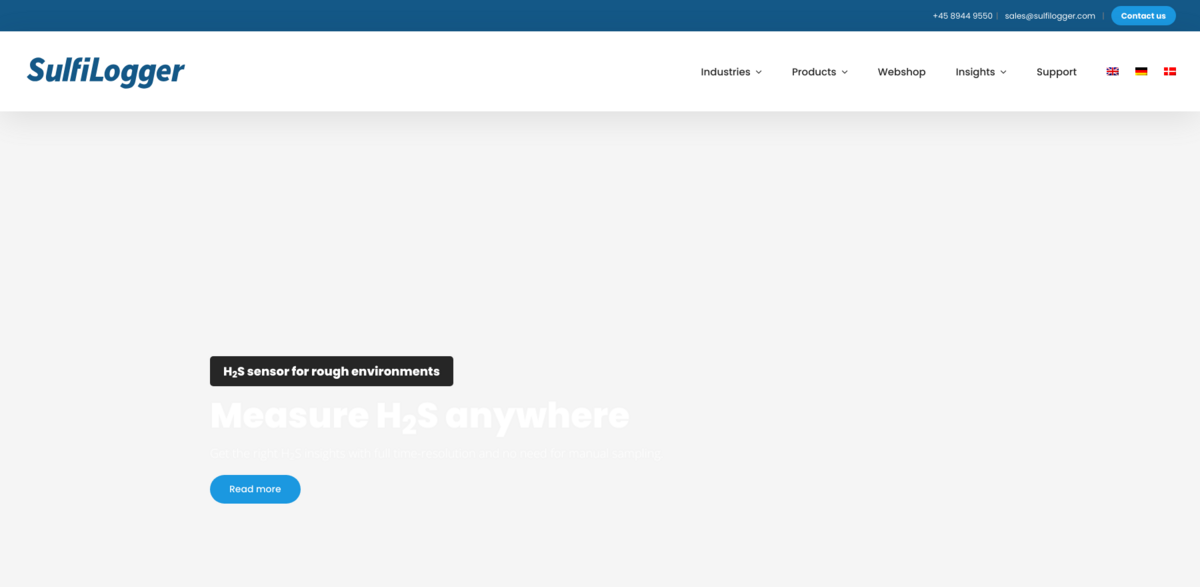What is the SulfiLogger™ H2S Sensor?
The SulfiLogger™ sensor is a cutting-edge device designed to continuously measure hydrogen sulfide (H2S) directly in wastewater, air, and inline process gases. It’s built tough to handle rough environments like untreated sewage and wet process gases, providing reliable, real-time data that helps industries take a proactive, data-driven approach to managing odor and corrosion. Whether it’s wastewater, biogas, or oil & gas, this sensor keeps a close eye on H2S levels, making complex sample conditioning systems a thing of the past.
Main Benefits of Using SulfiLogger™ Sensors
Here’s what makes the SulfiLogger™ X1 series stand out:
- Measure H2S almost anywhere—even in harsh, wet, and anaerobic conditions.
- Keep track of every change in H2S levels, no matter how subtle.
- Avoid the hassle and expense of complex sample conditioning systems.
- Increase asset lifespan by mapping networks with multiple sensors for smarter asset management.
- Prevent odors by pinpointing H2S hotspots and prioritizing mitigation efforts.
- Cost-optimize chemical dosing with real-time data driving automated dosing pumps.
- Manage sulfide problems right at the source by mapping complex sewer networks.
- Optimize industrial processes with continuous sensor feedback.
- Improve worker safety by detecting peak H2S loads early.
Industries Benefiting from SulfiLogger™
The SulfiLogger™ sensor is versatile and tailored for several key industries:
In wastewater treatment, it measures H2S directly in untreated sewage, unaffected by flow or turbulence, giving operators reliable insights. For biogas plants, it monitors H2S continuously right after anaerobic digesters or desulfurization steps, ensuring gas quality and safety. In oil & gas, it’s installed right after separators to track H2S development, eliminating the need for manual sampling and improving operational efficiency.
How SulfiLogger™ Enhances Process Control
Real-time data from the SulfiLogger™ sensor empowers operators to fine-tune their processes. By continuously monitoring H2S levels, it’s possible to adjust chemical dosing dynamically, optimize treatment steps, and prevent costly downtime or damage. This kind of control means processes run smoother, assets last longer, and environmental compliance is easier to maintain. Plus, the sensor’s rugged design means it keeps working reliably in tough conditions—no fuss, no downtime.
Ensuring Safety and Environmental Responsibility
Worker safety is a top priority, and the SulfiLogger™ sensor helps by detecting dangerous H2S peaks before they become a hazard. Early warnings allow for timely interventions, reducing health risks. Environmentally, it supports odor control and corrosion prevention, which means fewer complaints and less environmental damage. By managing sulfide issues at the source, it helps industries reduce their footprint and operate more sustainably.
Project Impact on Sustainable Development Goals (SDGs)
- SDG 6: Clean Water and Sanitation – by improving wastewater treatment and monitoring.
- SDG 7: Affordable and Clean Energy – through better biogas quality control.
- SDG 9: Industry, Innovation, and Infrastructure – via advanced sensor technology and process optimization.
- SDG 11: Sustainable Cities and Communities – by reducing odors and improving urban air quality.
- SDG 12: Responsible Consumption and Production – through optimized chemical dosing and resource use.
- SDG 13: Climate Action – by supporting cleaner industrial processes and reducing emissions.
- SDG 15: Life on Land – by preventing environmental contamination from sulfide pollution.
About SulfiLogger A/S and Quality Assurance
SulfiLogger A/S, based in Risskov, Denmark, brings over 20 years of expertise in sensor design and development. The company is committed to precision engineering, continuous innovation, and quality management. Their sensors are ISO9001:2015 certified, ensuring high standards in manufacturing, sales, support, and development. This dedication guarantees that SulfiLogger™ sensors remain reliable tools for industrial monitoring, meeting the evolving needs of modern industries worldwide.





















